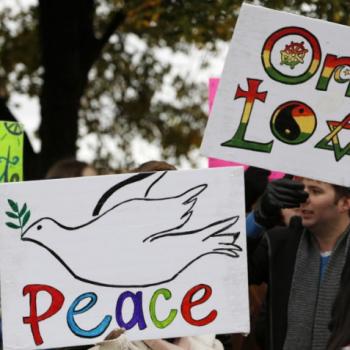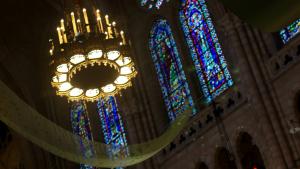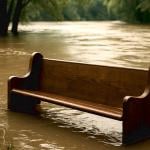This is part 1 of a 4 part series on Baptists, recorded by video for an instructional curriculum on mainstream Protestants over at this cool new online learning site for churches, ChurchNext (I know, I’m as surprised as you are that we made the mainstream list). So much thanks to friend, teacher, mentor, superstar Dr. Rosalie Beck, for her help remembering what I learned in class 25 years ago. Any inadvertent misinformation here is all mine, not hers!
Talking about Baptists is tricky because, like any group of human beings, their ranks are filled with numerous opinions and perspectives. But to make matters worse, Baptists are congregationalist in their polity—they don’t have a hierarchy telling them what to think or say or do, and everybody has a voice—which makes trying to tell you about who Baptists are and what they believe even trickier!
Even their history and origins are often in dispute; some Baptists have claimed roots all the way back to Jesus…John the Baptist, hello??!? But, honestly, that’s not where modern Baptists began. I’m going to try to get to the bottom of things here:
About 80 years after Martin Luther nailed his 95 theses to the church doors in Wittenberg and the Protestant Reformation began unfolding, there was a group of folks living in England who were mad at the Church of England.
 The English expression of the Protestant Reformation was the Church of England, and remember, the church and the state were one and the same back then. The Church of England began to draw criticism from folks who felt it wasn’t reformed enough: too rich, too corrupt, too tied to political power, too fancy. The people who began to object to the Church of England were called Puritans—they wanted to purify the church from within—to change it into what it should be. For them, that meant making sure the Church of England was purified of any trace of Catholic influence, that worship was simple, that Christ was head of the church—not the king.
The English expression of the Protestant Reformation was the Church of England, and remember, the church and the state were one and the same back then. The Church of England began to draw criticism from folks who felt it wasn’t reformed enough: too rich, too corrupt, too tied to political power, too fancy. The people who began to object to the Church of England were called Puritans—they wanted to purify the church from within—to change it into what it should be. For them, that meant making sure the Church of England was purified of any trace of Catholic influence, that worship was simple, that Christ was head of the church—not the king.
Among that group of Puritans in the early 1600s there arose another, more radical group, called Separatists. Separatists didn’t think there was much hope for the church as it was, and they wanted the freedom to go outside the church—to become (you guessed it) separate. That idea, of course, was fraught with all kinds of trouble, not the least of which that it made King James really, really mad.
Two men in this group of Separatists were named Thomas Helwys and John Smyth, and because their views about the church were making life a bit dangerous for them and their families, they packed everybody up—about 40 people—and went to Amsterdam to hang out with some Mennonites. There they concluded that baptism should only be undertaken by adults—not infants, as practiced in the Church of England. Baptism by consenting adults who had made their own decisions of faith was their new conviction…which meant, of course, that they now considered their own baptisms as infants invalid. To remedy that, John Smyth rebaptized everyone…including himself.
(That would have been interesting to watch in person….)
In 1612 Thomas Helwys and a group of 12 decided to return to England and start a church. They were General Baptists—Arminian in their perspective—with the position that God’s grace and salvation are open to anyone who responds. After their return home Thomas Helwys wrote a book called A Short Treatise on the Mystery of Iniquity—a foundational work about religious liberty. For his trouble he was thrown in jail, where he eventually died.
Meanwhile, all across England and in London in particular, pockets of religious dissent were popping up all over the place. Another Baptist church was formed during that time—called the JLJ church, after the initials of its founders: Henry Jacob, John Lathrop, and Henry Jessey. At the JLJ church they practiced adult believers’ baptism by immersion, but they were Particular Baptists: that is, they adhered to the thought of John Calvin with regard to particular atonement: God’s chosen were preordained before the beginning of time—God has already picked the people who will be saved.
And so, by the 1640s, these strange groups adhering to this curious practice of adult believers’ baptism became known as “Baptists.” While the specifics of their theology varied (like the differentiation between General and Particular Baptists), what bound them together was the practice of adult believers’ baptism. And, their groups were marked by a radical openness to God’s gifts: the idea that God works when and where God will, in and through anybody God chooses.
By the 1640s, in fact, folks were so concerned about these strange Baptists, that a publication called, “Lucifer’s Lackey or The Devil’s New Creation” was published in response. About the Baptists it reads: “When women preach and cobblers pray, the Devil makes a holiday!”
Eventually, as you know, some of these strange folk immigrated to America. They mostly settled in New England, where they acquired for a short time a member by the name of Roger Williams. Outspoken champion of religious liberty, Roger Williams was a Baptist for only four months…but he founded the first Baptist church in America, in Providence, Rhode Island.
And that’s how it all began…!











